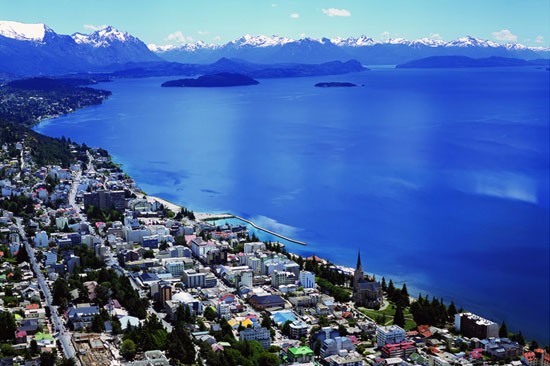Activities to do in Bariloche See map
San Carlos de Bariloche is located on the southern shore of Lake Nahuel Huapi, surrounded by the beautiful national park of the same name, 770 meters above sea level.
The space is divided by the typical steppe landscape in the east and rainforest in the Andes that emerges majestically over the west.
Counting on a wide range of offerings and services, the city receives more than 800,000 passengers annually, transforming tourism in the main local economic activity. It is also an important center for scientific and technological development nationally and internationally.
 Aerial view of downtown Bariloche. Photo courtesy of EMPROTUR.
Aerial view of downtown Bariloche. Photo courtesy of EMPROTUR.Weather
The climate belongs to continental cold dry season. Temperatures and rainfall are not uniform in the area occupied by the National Park. An important variation in rainfall is produced from west to east, between the border with Chile and the Limay River, respectively. For its part, the temperature decreases sharply from the lower slopes to the summit of the hills. These climatic variations in addition to differences in soil geomorphology relief and result in significant changes in vegetation and fauna.
In summer the days are warm and sunny with cool nights, low rainfall and prevailing winds from the southwest. The average temperature is 18°C, with highs of 29°C and lows of 9°C.
In autumn, the days are cool-temperate with cold nights. The temperature ranges between 4°C and 13°C, and the time is dominated by rain.
In winter the days are too cold with abundant snows. Temperatures range between 8°C and -10°C.
In spring there are fresh days that begin to lengthen and temperatures rise slowly, slowly decreasing the rainfall. The nights are cold, keeping daytime temperatures ranging between 7°C and 20°C by the end of the season.
 View of the Balseiro Institute in winter.
View of the Balseiro Institute in winter.Circuits
After a city tour you can take excursions to other destinations like the "Circuito Chico" or the "Circuito Grande".
If you do a tour by the civic center of the city you can visit:
- The Patagonia Museum is the museum of natural science, prehistory, ethnography, local history and exhibitions.
- Paleontological Museum with a wealth of dinosaur fossils, bones, claws and replicas, is located at the intersection of 12 de Octubre y Sarmiento.
- Show Ictícola (belonging to the Association Club of Fish and Game) is an exposure of trout "trophy" embalmed. It is located on 12 de Octubre and Onelli on the lake.
- Geological and Paleontological Museum "Rosendo Pascual" with the most important invertebrates library of Patagonia and also Patagonian birds, dinosaur bones and glass collection, which total about 10,000 pieces. It is in the Bosque Petrificado Street 367 in Villa Los Coihues.
- Art Gallery Cerro Otto Gondola - Cerro Otto Rivolving Café.
- Chocolate Museum on Avenida Bustillo 1200. Guided tours every 20 minutes and free shuttles from Mitre and Rolando.
- Craft Fair (outdoors) on Urquiza Street between Moreno y Mitre, next to the Civic Center.
- Bariloche Atomic Center and Balseiro Institute in which guided tours are free.
Other destinations that can be taken from Bariloche are Tronador, Otto, Leones and Viejo Hills, Tren Histórico Steam, Victoria Island, Blest Port and Los Cántaros waterfall, and finally, the international crossing lakes Andean.
Alojamiento en San Carlos de Bariloche
 Departamento Fancy Home
El FANCY HOME ofrece patio y wi fi gratis y se encuentra a 2 km de la playa El Centenario, a 600 metros del centro cívicover másTel: San Carlos de Bariloche
Departamento Fancy Home
El FANCY HOME ofrece patio y wi fi gratis y se encuentra a 2 km de la playa El Centenario, a 600 metros del centro cívicover másTel: San Carlos de BarilocheViajes por la Patagonia
Related Articles
© Patagonia.com.ar 2025 | Todos los derechos reservados.
